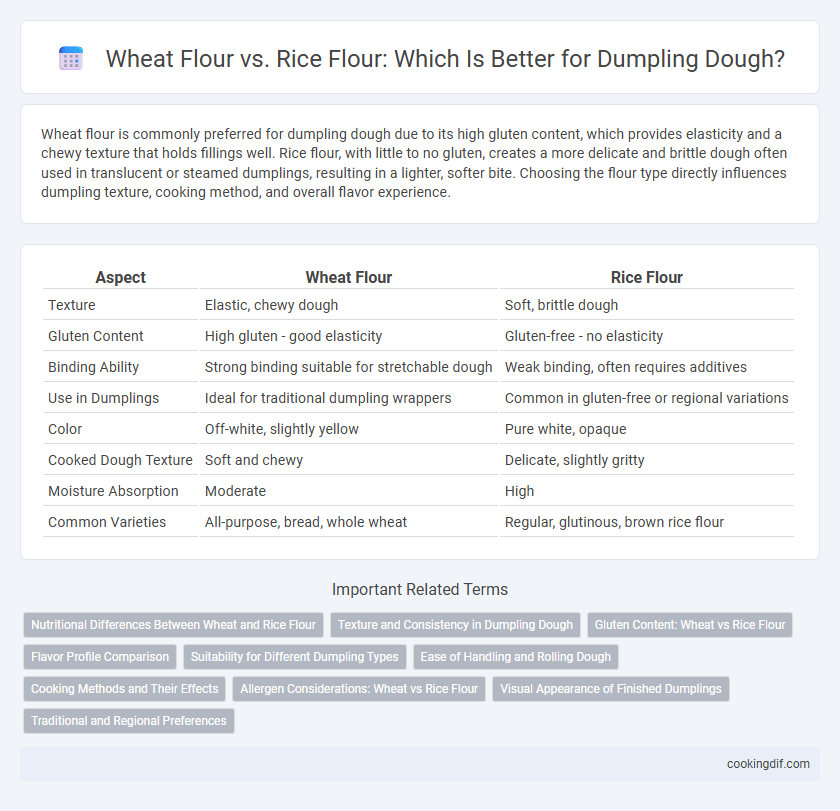Wheat flour is commonly preferred for dumpling dough due to its high gluten content, which provides elasticity and a chewy texture that holds fillings well. Rice flour, with little to no gluten, creates a more delicate and brittle dough often used in translucent or steamed dumplings, resulting in a lighter, softer bite. Choosing the flour type directly influences dumpling texture, cooking method, and overall flavor experience.
Table of Comparison
| Aspect | Wheat Flour | Rice Flour |
|---|---|---|
| Texture | Elastic, chewy dough | Soft, brittle dough |
| Gluten Content | High gluten - good elasticity | Gluten-free - no elasticity |
| Binding Ability | Strong binding suitable for stretchable dough | Weak binding, often requires additives |
| Use in Dumplings | Ideal for traditional dumpling wrappers | Common in gluten-free or regional variations |
| Color | Off-white, slightly yellow | Pure white, opaque |
| Cooked Dough Texture | Soft and chewy | Delicate, slightly gritty |
| Moisture Absorption | Moderate | High |
| Common Varieties | All-purpose, bread, whole wheat | Regular, glutinous, brown rice flour |
Nutritional Differences Between Wheat and Rice Flour
Wheat flour contains more protein and gluten, which provides elasticity and chewiness to dumpling dough, while rice flour is gluten-free and offers a lighter, more delicate texture. Nutritionally, wheat flour has higher fiber, iron, and B vitamins compared to rice flour, which is lower in calories and easier to digest for those with gluten sensitivities. Choosing between wheat and rice flour affects both the dough's structure and its nutritional profile, influencing overall health benefits and dietary suitability.
Texture and Consistency in Dumpling Dough
Wheat flour creates a dough with a chewier, more elastic texture due to its higher gluten content, making it ideal for dumplings that require a firm yet pliable wrapper. Rice flour dough lacks gluten, resulting in a softer, more delicate consistency that produces tender dumplings with a slightly grainy texture. The choice between wheat and rice flour directly influences the dough's stretchability and mouthfeel, affecting the overall dumpling eating experience.
Gluten Content: Wheat vs Rice Flour
Wheat flour contains a high gluten content, which provides elasticity and chewiness essential for dumpling dough, allowing it to stretch without tearing during folding or cooking. Rice flour lacks gluten, resulting in a more brittle and less elastic dough, often producing a softer, crumbly texture rather than the traditional chewy dumpling skin. Choosing between wheat and rice flour directly affects dough elasticity, texture, and the ability to hold fillings securely.
Flavor Profile Comparison
Wheat flour provides a rich, slightly nutty flavor with a chewy texture, making dumplings heartier and more filling. Rice flour offers a delicate, mildly sweet taste with a tender, softer bite, enhancing the lightness of dumpling wrappers. The choice between wheat and rice flour significantly influences the dumpling's overall flavor and mouthfeel.
Suitability for Different Dumpling Types
Wheat flour dough is ideal for traditional dumplings like potstickers and wontons due to its high gluten content, which provides elasticity and chewiness. Rice flour dough suits steamed or soft-textured dumplings, offering a delicate, slightly sticky consistency perfect for gluten-free options. Choosing between wheat and rice flour depends on the desired texture and cooking method, with wheat flour favored for pan-fried or boiled dumplings and rice flour preferred for steamed varieties.
Ease of Handling and Rolling Dough
Wheat flour dough offers superior elasticity and gluten formation, making it easier to handle and roll into thin, uniform dumpling wrappers. Rice flour dough tends to be more fragile and lacks stretchability, often requiring additives like tapioca starch to improve pliability. For consistent, smooth rolling and shaping, wheat flour is generally preferred in dumpling preparation.
Cooking Methods and Their Effects
Wheat flour produces a dough with higher gluten content, resulting in a chewy texture ideal for boiling, steaming, or pan-frying dumplings, as the dough maintains elasticity and resists breaking. Rice flour creates a gluten-free dough that is more fragile and has a softer, slightly grainy texture, often used in steaming methods where gentle cooking preserves its delicate structure. The choice between wheat and rice flour significantly influences cooking time and texture, with wheat flour dough requiring longer cooking to develop chewiness, while rice flour dough cooks quickly but demands careful handling to prevent tearing.
Allergen Considerations: Wheat vs Rice Flour
Wheat flour contains gluten, a common allergen that can trigger reactions in individuals with celiac disease or gluten sensitivity, making rice flour a safer alternative for allergen-conscious dumpling dough. Rice flour is naturally gluten-free and less likely to cause allergic responses, accommodating people with wheat allergies or sensitivities. Choosing rice flour enhances dough accessibility while maintaining texture suitable for various dumpling recipes.
Visual Appearance of Finished Dumplings
Wheat flour dumplings typically exhibit a translucent, smooth, and glossy finish that highlights a soft, elastic texture ideal for holding fillings securely. In contrast, rice flour dumplings often present a matte, slightly opaque appearance with a chewier and denser texture, resulting in a more rustic, handcrafted look. The choice between wheat and rice flour directly influences the dumpling's visual appeal, texture contrast, and overall presentation style.
Traditional and Regional Preferences
Traditional dumpling recipes across Asia often favor wheat flour for dough due to its gluten content, which provides elasticity and chewiness essential in Chinese and Eastern European varieties. In contrast, rice flour is predominantly used in Southeast Asian dumplings, such as Vietnamese banh cuon or Filipino puto, offering a softer, more delicate texture that complements regional ingredients. Regional preferences strongly influence flour choice, with wheat-based doughs common in northern, temperate climates, while rice flour doughs prevail in tropical, rice-producing areas.
Wheat flour vs Rice flour for dough type Infographic

 cookingdif.com
cookingdif.com